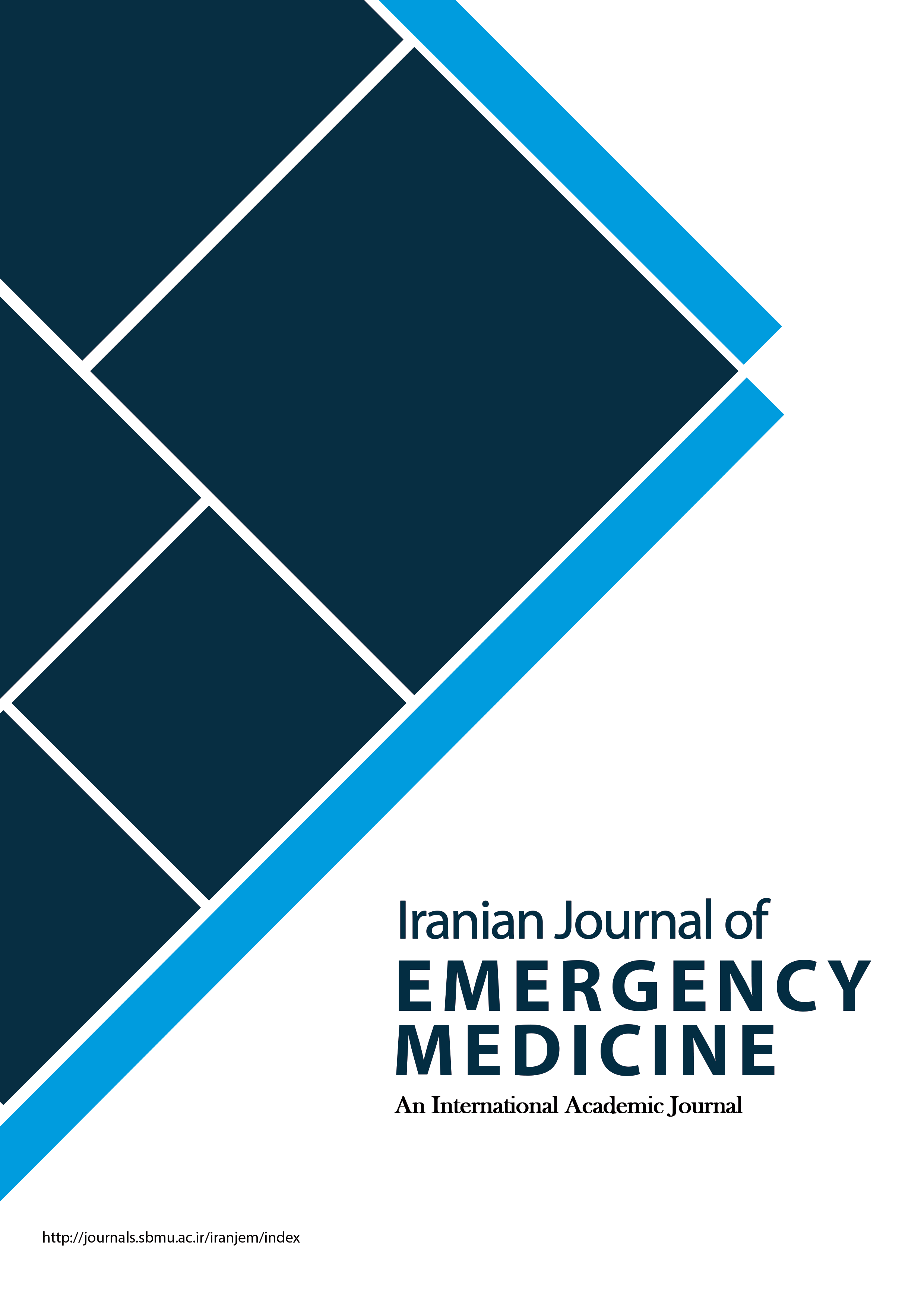Evaluating the Quality of Multiple Trauma Patient Records in the Emergency Department of Imam Khomeini Hospital in Urmia
Iranian Journal of Emergency Medicine,
Vol. 2 No. 2 (2015),
23 May 2015
,
Page 88-92
https://doi.org/10.22037/ijem.v2i2.7456
Abstract
Introduction: Medical profile is an important source of data regarding the patient, the illness, the doctor’s performance and leads to adequate diagnosis and treatment. Filling out medical profiles correctly, greatly decreases medical errors and leads to accurate diagnosis and proper treatment of the patients. This study aims to evaluate the quality of the patient records of trauma patients admitted to the emergency department of Emam Khomeini Hospital, Urmia, Iran. Methods: In a cross-sectional study, the medical profiles of trauma patients admitted to the emergency department of Emam Khomeini Hospital, Urmia, Iran in November 2013 were evaluated aiming to determine the quality of filling the profiles. All the patients’ medical profiles were evaluated regarding accurate recording of trauma mechanism; size, site of injuries; vital signs recordings; diagnostic and treatment plan. Based on the Likert scale, the quality of data recording was rated as: not recorded, recorded with high quality, recorded with low quality. The data were statistically analyzed using SPSS 21. Results: In this study, 795 profiles were studied and evaluated (66.7% male). The most accurate data recording belonged to mechanism of trauma (92.5%) and the least accurate data recording belonged to diagnostic plan (9%). The highest frequency of incomplete data belonged to the site of injuries caused by trauma (71.7%), the number of injuries (34%) and anatomical depth and severity of trauma (34%). Most cases of missing data belonged to diagnostic plan (91%). In 142 (17.8%) profiles only 1, in 241 (30.3%) profiles 2, and in 277 (34.8%) profiles 3 categories were incomplete and data recording in 135 (16.9%) profiles were incomplete in all categories. In total, 82% of the profiles had 1 or more incomplete categories. Conclusion: Based on the results of this study, the quality of data recordings of trauma patients admitted to the studied emergency department was not satisfying. The highest rate of incomplete data belonged to the site of injury caused by trauma and the highest rate of missing data belonged to diagnostic plan.- تروما؛ پرونده پزشکی؛ خطای پزشکی؛ تشخیص
How to Cite
References
Hillestad R, Bigelow J, Bower A, et al. Can electronic medical record systems transform health care? Potential health benefits, savings, and costs. Health Aff (Millwood). 2005;24(5):1103-17.
Miller RH, Sim I. Physicians’ use of electronic medical records: barriers and solutions. Health Aff (Millwood). 2004;23(2):116-26.
Wang SJ, Middleton B, Prosser LA, et al. A cost-benefit analysis of electronic medical records in primary care. The American journal of medicine. 2003;114(5):397-403.
Quinn C. The medical record as a forensic resource: Jones & Bartlett Learning; 2004. p.
Brennan TA, Localio RJ, Laird NL. Reliability and validity of judgments concerning adverse events suffered by hospitalized patients. Med Care. 1989;27(12):1148-58.
Leape LL, Lawthers AG, Brennan TA, Johnson WG. Preventing medical injury. Qual Rev bull. 1993;19(5):144-9.
O'Neil AC, Petersen LA, Cook EF, Bates DW, Lee TH, Brennan TA. Physician reporting compared with medical-record review to identify adverse medical events. Ann Intern Med. 1993;119(5):370-6.
Wilson RM, Runciman WB, Gibberd RW, Harrison BT, Newby L, Hamilton JD. The quality in Australian health care study. Med J Aust. 1995;163(9):458-71.
Abbassi S, Tavakoli N. Quantitative analysis of medical record of patients admitted in the gharazi hospital. J Health Inform Manag. 2011;8(1):50-60. [Persian].
Watzlaf VJ, Rudman WJ, Hart-Hester S, Ren P. The Progression of the Roles and Functions of HIM Professionals: A Look into the Past, Present, and Future. Perspectives in Health Information Management/AHIMA, American Health Information Management Association. 2009;6(Summer).
Saeed Afzali MAS, Sare Naghdi. Processing of File Record for Multiple Traumatic Patients in Hamedan’s Besat Hospital in 2008. Scientific Journal of Forensic Medicine. 2011;17(2):79 -85.
Mashoufi M, Rostami K, Mardi A. Assessment Records in Hospitals of Ardabil University of Medical Sciences in 2002. J Ardabil Uni Med Sci. 2006;3(11):43-9.
Houser SH, Manger BJ, Price BJ, Silvers C, Hart-Hester S. Expanding the health information management public health role. Perspect Health Inf Manag. 2009;6:1b.
Esmailian M, Nasr-Esfahani M, Brahimi A-S. The Quality of Patients’ Files Documentation in Emergency Department; a Cross Sectional Study. Iran J Emerg Med. 2014;1(1):16-21.
- Abstract Viewed: 661 times
- PDF (فارسی) Downloaded: 3291 times
- HTML (فارسی) Downloaded: 50 times



